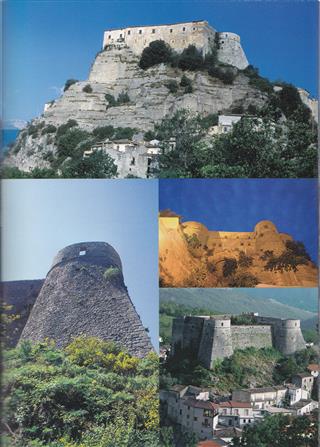Castelli del Molise
Castello Pandone - Cerro al Volturno
|
La differente fattura delle torri che difendono il castello di
Cerro al Volturno lascia intendere che gli interventi subiti nel tempo
dall'edificio furono numerosi.
Le sue vicende si intrecciano con quelle della vicina abbazia di
San Vincenzo al Volturno: venne infatti fatto costruire dai monaci nel X secolo
su di una massa rocciosa a 500 metri di altezza, in luogo di un recinto
longobardo, con funzioni di vedetta sull'alta valle del fiume Volturno.
La fortezza fu modificata in seguito al terremoto del 1349,
quindi nel XV secolo dai Pandone e nel XVII secolo dai Colonna. Quest'ultima
famiglia lo vendette ai Lombardi, attuali proprietari, nel 1828.
Il castello è a forma di parallelepipedo con cortile centrale ed
è difeso da torri, realizzate in tempi diversi, su tutti i lati. Tra tutte si
evidenziano quelle dei lati settentrionale ed occidentale perché circolari nella
parte alta mentre in basso appaiono come possenti bastioni. L'interno del
castello è stato completamente modificato. Gli eventi subiti nel tempo
dall'edificio furono numerosi.
L'interno del castello è stato completamente modificato. |

|
Pandone Castle - Cerro al Volturno
 |
The different types of towers, built up to defend the Castle of
Cerro al Volturno village are a clear example of the additions, the alterations
and the reconstructions which the castle underwent.
The history of the castle is closely interwoven with the history
of the neighbouring San Vincenzo al Volturno Abbey. |
In the 10th century the monks themselves commissioned the
building up of a castle located on a ridge overlooking the Volturno River deep
valley, at 500 metres above sea level. It replaced a former Lombard enceinte.
Then, the stronghold underwent a restoration because of an earthquake in 1349.
The castle history in 15th and 17th centuries was of alterations
to satisfy the needs and aspirations of Pandone and Colonna families,
respectively.
The latter sold it to Lombardi family, the present owner, in
1828.
The parallelepiped shaped castle, which has a central courtyard,
is fitted with towers, on each side, built up at different times. The round
upside of the towers, located on the north and west sides, is different from the
lower imposing rampart. The castle interior underwent substantial alterations.